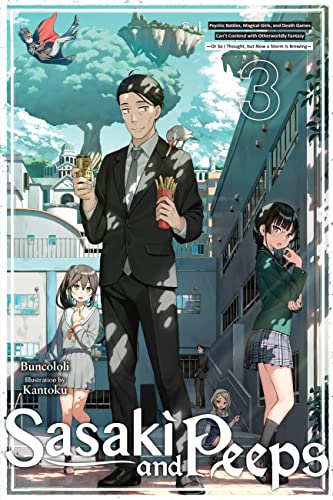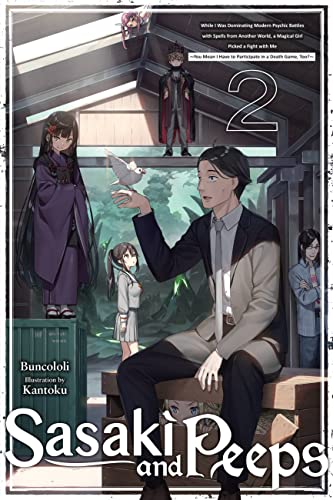By Buncololi and Kantoku. Released in Japan as “Sasaki to Pi-chan” by Media Factory. Released in North America by Yen On. Translated by Alice Prowse.
It’s getting better. There are still a few times where I wince while reading the series, mainly whenever the neighbor girl is trying to manipulate Sasaki into sexually assaulting her (he doesn’t), but for the most part the series is doing what it does best: mashing up genre after genre and watching our deadpan salaryman crush all of them as he flies past. Sasaki may be a bit of a stoic sad sack, but the series wouldn’t work at all if the protagonist were, say, Kazuma from KonoSuba. It not only requires his experience as a Japanese salaryman to drive a lot of the plot, but also his reserve helps the reader glide through the plot without taking anything too seriously. Which is good, because this series is still mostly a comedy, but also bad, because there are a lot of things I think could do with being taken more seriously, such as getting the neighbor girl some therapy.
Sasaki continues to juggle the various light novel plots he finds himself in. In the fantasy world, the count’s daughter Elsa is being taken as a “concubine” by an evil Duke, so Sasaki agrees to help fake Elsa’s death and take her with him to Japan, where she can hide out in a hotel. In the “psychic” world, he continues to investigate mysterious happenings (most of which have to do with one of the other genres he’s in) while trying to get enough blackmail material on his suspicious boss. In the “magical girl” part of the book, he finds her trying to murder another psychic. Sadly, before that gets anywhere, he’s dragged into the “angels vs. demons death game” genre we started to see last time, and finally discovers what the neighbor girl has been up to. Unfortunately, everything completely is blown to hell and back due to one fatal mistake: he lets Peeps get drunk.
I do suspect a lot of the salaryman humor in this lands better in Japan than it does here – he’s constantly apologizing to the girls around him, and thanking them for their support of him, in a way that is meant to evoke the office even as it happens while they’re watching demons blow teenage girls’ heads off. The best part of the book was seeing the neighbor finally get drawn into the main plotline as opposed to being a very uncomfortable side story. She’s still very uncomfortable – I hate using the word yandere, but it does apply here, and her rape/suicide fantasies are deliberately disturbing – but now that she’s involved with everyone else, hopefully she can get a little help? Maybe? The book ends in a four-way Mexican standoff between all of the various underage girls Sasaki has pulled into his orbit – none of whom he’s remotely romantically interested in, but I see what you’re doing there. And that doesn’t even count the traditional “looks nine but is decades older” girl. Which, again, light novel trope.
It appears we’re adding aliens to the stack of plots if the cliffhanger is to be believed, though if I were Sasaki I’d worry more about calming down his not-harem first. This series is absolutely not for everyone, but if you have drenched yourself in light novel plots over the years, it can be a lot of fun.



